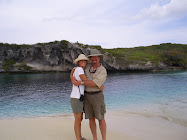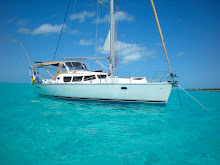
Monday, April 11, 2011 (nope things are not out of order, it’s really 6/25/11 but we’re trying to be chronological). When last we left off we were preparing to leave St. Martin behind, so bright and early on 4/11, actually 1100 hours we are off for St. Barts. Our plan is to overnight there and then head onto Antigua.
On a heading of 140* with an easterly wind at 12-20k we manage a great 20nm sail. Our position and the seasons have changed so that we are once again a sailboat. With moderate seas we sit back and enjoy the ride. We read, “saildick” (the unnecessary manipulation of the set of the sails for want of something to do), nap and as it is a Monday discuss what the wealthy working folks are up too, :}. April showers bring May flowers, well the setting of the trade winds bring bigger seas and rain. So as we make our final approach we are hit with bigger waves and lots of rain. Time to get out the buckets and collect some water.
St. Barts has a colorful history, lying midway along the Lesser Antilles it has served pirates, politicians and rebels. Having been swapped back and forth between Britain, Spain, France and even Sweden the islanders and the island have had some whiplash. During the American Revolution the island served as a supply depot for the rebels. Today, St. Barts is a part of France and although the allure has faded a bit it is/was the haunt of the rich and famous. Of course we stopped by because it was along the way and the moorings are free.
Revolution the island served as a supply depot for the rebels. Today, St. Barts is a part of France and although the allure has faded a bit it is/was the haunt of the rich and famous. Of course we stopped by because it was along the way and the moorings are free.
Making landfall at Ile Fourche we grab a mooring and settle in for the weather and the beautiful view. While a picturesque location the anchorage can prove to be a bit bumpy as the swell seems to bounce back of the island and roll across the bay. From our observations we assume we are moored in the middle of what was once a large volcano, the slopes of the hills appear to have a good deal of sulphur content and the cone is still visible.
After a bumpy night we drop the mooring and are off for Anse de Columbier on St. Barts proper. Here you will find an excellent anchorage with a nice cooling breeze and mild swell. One can anchor in 15-20’, however we opted for a mooring as they are free. While we had planned to stay only one night we ended up staying for four as we explored the island and visited the main port of Gustavia, via the dink. Don’t tell anyone but we never checked in, keeping true to the swashbuckler spirit of the island.
As far as ports go Gustavia is very uncomfortable. There are several marinas and mooring fields, however the constant swell bangs boats about quite a bit. We were very happy with Columbier and the short ride around the point to town. During our time on St. Barts it rained every night, enough to wash down the decks and to keep the water tanks topped off. This just goes to show you it’s not all sunshine and umbrella drinks.
On a heading of 140* with an easterly wind at 12-20k we manage a great 20nm sail. Our position and the seasons have changed so that we are once again a sailboat. With moderate seas we sit back and enjoy the ride. We read, “saildick” (the unnecessary manipulation of the set of the sails for want of something to do), nap and as it is a Monday discuss what the wealthy working folks are up too, :}. April showers bring May flowers, well the setting of the trade winds bring bigger seas and rain. So as we make our final approach we are hit with bigger waves and lots of rain. Time to get out the buckets and collect some water.
St. Barts has a colorful history, lying midway along the Lesser Antilles it has served pirates, politicians and rebels. Having been swapped back and forth between Britain, Spain, France and even Sweden the islanders and the island have had some whiplash. During the American
 Revolution the island served as a supply depot for the rebels. Today, St. Barts is a part of France and although the allure has faded a bit it is/was the haunt of the rich and famous. Of course we stopped by because it was along the way and the moorings are free.
Revolution the island served as a supply depot for the rebels. Today, St. Barts is a part of France and although the allure has faded a bit it is/was the haunt of the rich and famous. Of course we stopped by because it was along the way and the moorings are free.Making landfall at Ile Fourche we grab a mooring and settle in for the weather and the beautiful view. While a picturesque location the anchorage can prove to be a bit bumpy as the swell seems to bounce back of the island and roll across the bay. From our observations we assume we are moored in the middle of what was once a large volcano, the slopes of the hills appear to have a good deal of sulphur content and the cone is still visible.

After a bumpy night we drop the mooring and are off for Anse de Columbier on St. Barts proper. Here you will find an excellent anchorage with a nice cooling breeze and mild swell. One can anchor in 15-20’, however we opted for a mooring as they are free. While we had planned to stay only one night we ended up staying for four as we explored the island and visited the main port of Gustavia, via the dink. Don’t tell anyone but we never checked in, keeping true to the swashbuckler spirit of the island.
As far as ports go Gustavia is very uncomfortable. There are several marinas and mooring fields, however the constant swell bangs boats about quite a bit. We were very happy with Columbier and the short ride around the point to town. During our time on St. Barts it rained every night, enough to wash down the decks and to keep the water tanks topped off. This just goes to show you it’s not all sunshine and umbrella drinks.
 Although we cannot recommend the port, the town itself is wonderful; picturesque streets with wonderful old buildings, great views and plenty of eating places. So do plan to stop by. Well, it’s that time again. We need to make tracks in order to arrive in Antigua for the annual Classics Regatta and to meet up with some old friends. So Thursday April 14th we drop our mooring at 1430 hours and head off on our 80nm overnighter. As we head out of the anchorage we pass by “Pinta” whom we had last seen in the lagoon of St. Martin and from whom we picked up several parcels for “Arita”. The pont express had nothing on the crusiers mail transfer system. Dieter, the captain of “Pinta” is heading south to Guadeloupe to pick up his wife who has been back in Germany for several months, but that is a story for another time. As we set our sails we are greeted by a rainbow, a lovely sight. Of course immediately behind the rainbow are those wonderful thunderheads.
Although we cannot recommend the port, the town itself is wonderful; picturesque streets with wonderful old buildings, great views and plenty of eating places. So do plan to stop by. Well, it’s that time again. We need to make tracks in order to arrive in Antigua for the annual Classics Regatta and to meet up with some old friends. So Thursday April 14th we drop our mooring at 1430 hours and head off on our 80nm overnighter. As we head out of the anchorage we pass by “Pinta” whom we had last seen in the lagoon of St. Martin and from whom we picked up several parcels for “Arita”. The pont express had nothing on the crusiers mail transfer system. Dieter, the captain of “Pinta” is heading south to Guadeloupe to pick up his wife who has been back in Germany for several months, but that is a story for another time. As we set our sails we are greeted by a rainbow, a lovely sight. Of course immediately behind the rainbow are those wonderful thunderheads. 

No comments:
Post a Comment